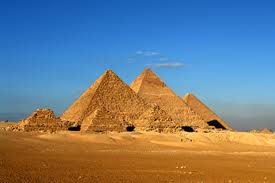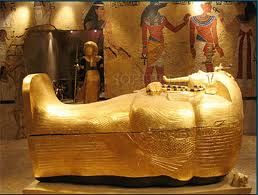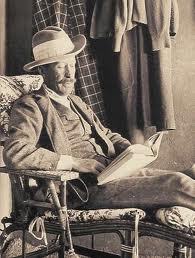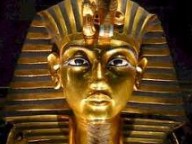图坦卡蒙是古埃及第18王朝的一位法老,他19岁时英年早逝,被葬于帝王谷中沉睡了三千多年。有人传说他的墓室内镌刻着这样一条咒语——惊扰法老者难逃一死。1922年,霍华德·卡特率领的考古队发现并开掘了图坦卡蒙墓。而伴随着法老木乃伊及惊世陪葬品重见天日,那条神秘的诅咒也仿佛真的应验了⋯⋯
 Stories of "the mummy's curse" excited the world after the discovery in 1922 of Egyptian King Tutankhamun (Tut)'s tomb.
Stories of "the mummy's curse" excited the world after the discovery in 1922 of Egyptian King Tutankhamun (Tut)'s tomb.
1922年,埃及法老图坦卡蒙的陵墓被世人发现,由此引发的“木乃伊诅咒”之说震惊了全世界。
Discovering Tut's Tomb 发现图坦卡蒙墓
The Great Pyramids1) are the most recognizable royal tombs of Egypt, but most ancient Egyptian kings and queens were in fact buried in the more hidden Valley of the Kings, where the riches in the tombs would be safe from tomb raiders2).
English archaeologist3) Howard Carter, and his sponsor Lord Carnarvon, obtained permission to dig in the Valley of the Kings and began excavation4) in 1917. After 5 years of searching, they still found nothing.
One area they had not attempted to dig was so worked over5) by past expeditions6) that it did not seem worthwhile to investigate any further. But while there, the workers found a series of steps when removing an ancient workman's hut.
Carter quickly ordered the steps to be cleared of sand and debris7) and by noon the next day they found a doorway, stamped with the seal of the royal necropolis8). They had discovered the ancient tomb of King Tut! The tomb contained riches beyond belief, and Carter was the first person to see them for over 3,000 years.
大金字塔是埃及最为知名的皇家陵墓群,但实际上,大部分古埃及法老及王后死后都被葬在一个更为隐蔽的所在——帝王谷,因为在那儿,他们墓中的宝藏可以免受盗墓者的侵扰。
英国考古学家霍华德·卡特和他的赞助人卡那封勋爵被获准发掘帝王谷,并于1917年开始了挖掘工作。长达五年的搜索之后,他们仍旧一无所获。
当时有一块地方是他们从没想过要挖的,因为那儿已经被之前的考察队刨了个底朝天,好像没什么进一步勘察的价值了。然而就在那儿,工人们竟在拆除一间古代工匠住的小屋时发现了几级台阶!
卡特立即命人将台阶上的沙土和瓦砾清理干净。第二天中午时分,他们找到了一个入口,其上赫然盖着皇室墓地的封印。他们发现的竟是图坦卡蒙法老的古墓!墓中藏放着令人难以置信的财宝,而卡特则是三千多年来第一个亲眼见到这些财宝的人。
Revenge9) of the Mummy? 木乃伊的报复?  Less than two weeks after the tomb's official opening, Lord Carnarvon was bitten on the cheek by a mosquito. He further aggravated10) the bite while shaving, and it soon became infected. Carnarvon suffered a high fever and died soon after. As Lord Carnarvon died, the lights of Cairo mysteriously went off.
Less than two weeks after the tomb's official opening, Lord Carnarvon was bitten on the cheek by a mosquito. He further aggravated10) the bite while shaving, and it soon became infected. Carnarvon suffered a high fever and died soon after. As Lord Carnarvon died, the lights of Cairo mysteriously went off.
The "curse of the mummy" also spread to others associated with the tomb. Arthur Mace, a fellow archaeologist, met an early death shortly after entering the tomb. Radiologist11) Archibald Reid, whose equipment was used to test the age of the tomb, went back home to England, suffering from fatigue, and died soon after his arrival.
The story continues, stating that in the 6 years after King Tut's tomb was revealed, 12 witnesses died. And within 10 years, only 2 of the original excavation team still lived. About 25 others connected with the expedition also died unexpectedly.
The media went wild with these stories. They claimed King Tut wanted revenge, and declared there was a mummy's curse that targeted those who had entered the tomb. Rumors spread that on the day of the tomb's opening, Lord Carnarvon's pet canary12) was attacked and eaten by a cobra13), a protector of the ancient Pharaohs14), and at the exact moment of his owner's death, Carnarvon's dog howled15) loudly and then died. They say that the curse has continued in more modern times. In 1966, relics16) from the tomb were to be sent to Paris for exhibition. Mohammed Ibrahim, Egypt's director of antiquities17) had a dream that someone would die if they went ahead with the planned trip and begged that the treasures be kept in Egypt. He was ignored. On his way to a final meeting in Cairo, Ibrahim was hit by a car and killed instantly. In 1972, Ibrahim's successor, Dr. Gamal Mehrez, was in charge of Tut's death mask as it was being moved to London for exhibition. He was not superstitious, but when he had just finished directing the preparations, and was about to leave the Cairo Museum, he fainted and died of circulatory collapse18).
 图坦卡蒙墓被正式挖开后不到两周,卡那封勋爵的脸就被蚊子叮了一口。他刮胡子的时候令创口更加严重了,导致创口迅速感染。之后他高烧不退,没过多久就去世了。而就在卡那封勋爵闭上眼睛的那一刻,开罗竟发生了全城停电的怪事。
图坦卡蒙墓被正式挖开后不到两周,卡那封勋爵的脸就被蚊子叮了一口。他刮胡子的时候令创口更加严重了,导致创口迅速感染。之后他高烧不退,没过多久就去世了。而就在卡那封勋爵闭上眼睛的那一刻,开罗竟发生了全城停电的怪事。
“木乃伊的诅咒”也蔓延到了其他与图坦卡蒙墓有关的人身上。阿瑟·梅斯,另一位考古学家,在进入墓室后不久就意外早逝了。为勘察组提供设备用于检测墓龄的放射学家阿奇博尔德·里德刚一回到英格兰的家中,就因过劳症很快死去了。
传言还在继续:在图坦卡蒙墓重见天日后的六年里,共有12名当时在场的人死亡。在其后的10年时间里,原考古勘察小组的成员只有两人得以存活,另外约25名与勘察相关的人员也都意外离世了。
媒体开始大肆渲染这些故事。他们断言图坦卡蒙法老企图报复,还宣称存在一个“木乃伊的诅咒”,谁进入过墓室,就会施与到谁身上。还有传言称,就在图坦卡蒙墓被打开的当天,卡那封勋爵的宠物金丝雀遭到一条眼镜蛇的攻击并被吃掉了,而眼镜蛇恰是古代法老的守护神;还说在卡那封勋爵去世的那一刻,他的狗也在高声嗥叫之后死去了。媒体报道说,即便是在更接近现代的时期,“木乃伊的诅咒”仍在持续。1966年,在图坦卡蒙墓的出土文物即将被送往巴黎展出之前,埃及文物局局长穆罕默德·易卜拉欣做过一个梦,梦到如果既定行程不变,就会有人遭遇死亡的厄运。于是他乞求将这些宝物留在埃及境内。然而,相关方对他的提议置若罔闻。结果,他在前往开罗参加最后一次会议的路上遭遇车祸当场死亡。1972年,易卜拉欣的继任者贾迈勒·迈赫雷兹博士负责将图坦卡蒙的陪葬面具送往伦敦参展。他是个不信邪的人,然而,就在他刚刚指挥完筹备工作准备离开开罗博物馆的时候,却突发循环系统衰竭,昏厥之后再也没有醒来。
The Facts Against the Curse “诅咒说”的真相
But did King Tut's Tomb really unleash19) a curse?
The best argument against the curse's existence is the natural death of Howard Carter. Carter survived until March 1939, right before he turned 65 and nearly 17 years after entering the tomb—a decade of which was spent working in the tomb itself. Why didn't he suffer the curse of the mummy? He was, after all, the first to enter the tomb.
The facts tell a less dramatic story: Of the 26 people present at the opening of the burial chamber, only 6 had died within the next 10 years. In fact, many of the people who had the most contact with Tut's mummy lived long lives.
图坦卡蒙墓真对进入墓室的人施与诅咒了吗?
能推翻“诅咒说”的最有力论据就是霍华德·卡特的寿终正寝。卡特一直活到1939年3月,他即将年满65岁的时候,此时距他进入图坦卡蒙墓已经时隔17年了——这其间他甚至还在墓中工作了10年。为什么“木乃伊的诅咒”没有施与到他的身上呢?要知道,他可是第一个进到墓室中的人!
事实的真相并不如媒体疯传得那样具有戏剧性:在亲临图坦卡蒙墓开掘现场的26人中,其实只有六个人死于之后的10年内。而且实际上,许多与图坦卡蒙木乃伊多次打交道的人最终都很长寿。
Were Tomb Toxins20) to Blame? 有毒物质是罪魁祸首?
In recent years a scientific theory for the mummy's curse has been offered for Carnarvon's death—he was in fact killed by exposure to ancient bacteria21) from the sealed tomb, which proved too much for his immune system, weakened by an illness he had before coming to Egypt.
"When you think of Egyptian tombs, you have not only dead bodies but foodstuffs—meats, vegetables, and fruits—buried for the trip to the afterlife22)," said Jennifer Wegner, an Egyptologist at the University of Pennsylvania Museum in Philadelphia. "It certainly may have attracted insects, molds23), bacteria, and those kinds of things."
Recent laboratory studies have revealed that some ancient mummies and tomb walls do indeed carry molds. These molds can cause allergic reactions ranging from congestion24) to bleeding in the lungs. The toxins can be particularly harmful for people with weakened immune systems. Scientists have also detected ammonia25) gas, formaldehyde26), and hydrogen sulfide27) inside sealed sarcophagi28). In strong concentrations they could cause burning in the eyes and nose, pneumonia29)-like symptoms, and in very extreme cases, death.
卡那封勋爵是被“木乃伊的诅咒”害死的吗?关于这个问题,近年来人们提出了这样一种科学理论——卡那封勋爵其实是因为感染了封闭墓室中的古老细菌而死去的。他在去埃及之前已然疾病缠身免疫力下降,墓室内的细菌对他而言就更是“难以承受之轻”了。
“埃及古墓中不仅有尸体,还有为转世途中所准备的食物——肉类、蔬菜、水果等,”来自宾夕法尼亚大学博物馆的埃及古物学家珍妮弗·韦格纳说,“这些东西可能招致昆虫、霉菌、细菌等东西。”
最近的实验研究表明,一些古代木乃伊和古墓的墙壁上的确附有霉菌。这些霉菌会引起从充血到肺出血等多种过敏反应。而这些有毒物质对于免疫系统低下的人可能尤为有害。科学家还在密闭的石棺中探测到了氨气、甲醛以及硫化氢。在高浓度情况下,这些气体可能造成眼、鼻的刺痛感,导致类似肺炎的症状,在某些极端情况下还可能致人死命。
The Other Way Around 另外一种声音 But experts who have examined the case of Lord Carnarvon believe that tomb toxins played no role in his death.
But experts who have examined the case of Lord Carnarvon believe that tomb toxins played no role in his death.
The elderly Carnarvon was chronically30) ill before he set foot in Tut's tomb. Plus, his death occurred months after his initial exposure to the tomb. If he had been exposed to toxic bacteria in the tomb, symptoms would have revealed themselves sooner.
Wegner hasn't noticed much concern among her colleagues at tomb sites. "On the archaeological projects that I've been involved with, we generally don't wear masks or other protection against toxic materials in a tomb," she explained. "If we do, it's because of worry about breathing in dust rather than molds or fungus."
"There are countless examples of tombs being infected by people, rather than tombs infecting people," said F. Dewolfe Miller, professor at the University of Hawaii. "The opening of these tombs by people who are eager to make discoveries without a mind on how to protect them can expose the tombs to enormous damages. Moisture has spawned31) molds, growing on walls and destroying paint and other antiquities."
然而,卡那封勋爵事件的调查专家都认为墓室中的有毒物质和他的死并无关系。
年迈的卡那封勋爵在进入图坦卡蒙墓之前就长年体虚病弱。此外,他的死发生在他首次进入墓室的数月之后。如果他的确在墓室中感染了有毒的细菌,他应该之后不久就发病才对。
韦格纳留意到,她的同事在勘察墓室时并没有过多担心感染细菌。“在我所参与的考古项目中,我们通常不带面罩,也不采取其他措施防范墓室内的有毒物质,”她解释说,“即使我们采取了什么措施,也是因为担心吸入灰尘,而不是霉菌或者真菌。”
“墓室被人类所污染的例子反倒是不计其数,远远超过了人类在墓室中被感染的例子,”夏威夷大学教授F·德沃尔夫·米勒说,“有些人一心想着有所发现,全然不顾陵墓的保护,导致陵墓在开挖过程中遭致巨大损毁。湿气滋生了霉菌,蔓延于墙壁之上,壁画以及其他古物全都被毁了。”
1. the Great Pyramids: 大金字塔。开罗西南10公里处的吉萨区(Giza)有三座很大的金字塔,分别是胡夫(Khufu)金字塔、哈夫拉(Khafre)金字塔和孟考拉(Menkaure)金字塔,三者被统称为大金字塔。
2. raider [5reIdE(r)] n. 侵入者;劫掠者
3. archaeologist [7B:kI5ClEdVIst] n. 考古学家
4. excavation [7ekskE5veIFEn] n. 发掘;挖掘
5. work over: 彻底检查
6. expedition [7ekspI5dIFEn] n. 考察队
7. debris [5debri:, 5deIb-] n. (被毁物的)残骸;瓦砾
8. necropolis [ne5krCpElIs] n. 墓地(尤指古代城市的大墓地)
9. revenge [rI5vendV] n. 复仇;报复
10. aggravate [5A^rEveIt] vt. 加重,加剧;使恶化
11. radiologist [7reIdI5ClEdVIst] n. 放射学家,(应用)辐射学家
12. canary [kE5neErI] n.【鸟】金丝雀
13. cobra [5kEubrE] n.【动】眼镜蛇
14. Pharaoh [5fZErEu] n. 法老(古埃及君王称号)
15. howl [haul] vi. (狼、狗等)凄厉地长嚎;嗥叫
16. relic [5relIk] n. 遗物
17. antiquity [An5tIkwEtI] n. [常作antiquities] 古物
18. circulatory collapse: 循环衰竭;circulatory [7s\:kjJ5leItErI, 5s\:kjUlEtErI] adj. (血液等)循环的;collapse [kE5lAps] n. (健康等的)垮掉
19. unleash [7Qn5li:F] vt. 发出
20. toxin [5tCksIn] n.【生化】【生】毒素;toxic [5tCksIk] adj. (有)毒的;毒性的;有害的
21. bacteria [bAk5tIErIE] n. [bacterium的复数] 细菌
22. afterlife [5B:ftElaIf] n. 死后(灵魂)的生活
23. mold [mEuld] n. <美> = mould [mEuld] n. 霉;霉菌
24. congestion [kEn5dVestFEn] n. 充血
25. ammonia [E5mEunjE] n.【化】氨
26. formaldehyde [fC:5mAldI7haId] n.【化】甲醛
27. sulfide [5sQlfaId] n. <美>【化】硫化物
28. sarcophagi [sB:5kCfE^aI, -dVaI, -^i:] n. [sarcophagus的复数] (常有精美雕刻装饰的)石棺;大理石棺
29. pneumonia [nju:5mEunjE] n.【医】肺炎
30. chronically [5krCnIkElI] adv. (疾病)慢性地;(人)久病地
31. spawn [spC:n] vt. 造成,引起
